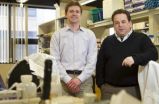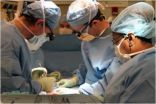With a grant from the National Institutes of Health's National Heart, Lung, and Blood Institute (NHLBI), Dr. Karina Davidson, director of the Center for Behavioral Cardiovascular Health at CUMC, and her team completed a randomized controlled trial with 150 patients with elevated depressive symptoms two to six months after hospitalization for heart disease. Patients were recruited from seven centers across the United States (NewYork-Presbyterian Hospital/Columbia University Medical Center; Washington University; University of Pennsylvania; Emory University – two sites; and Yale University – two sites); 73 received six months of patient-preference depression care, and 77 received six months of depression care determined by their physician upon notification that the patient had elevated depressive symptoms.
Dr. Davidson will give a presentation about these findings today at the Society of Behavioral Medicine 2013 Annual Meeting & Scientific Sessions (San Francisco, March 20-23). The study was published online on March 7, 2013, in JAMA Internal Medicine.
In the study, those in the patient-preference group were given a choice of therapy or antidepressants, or both. "We tried to help them really think through, what does it take to take a pill every day, what it takes to talk to a person about painful feelings and do homework. We then considered what would fit into their life," said Dr. Davidson. "Every six to eight weeks, we revisited how their chosen treatment was working for them and helped them make adjustments based upon their feedback."
Therapy in this study was given virtually (by phone or web-based) by two counselors (one at CUMC and one at Yale), to ensure that patients had access to clinicians of a similar skill set. The virtual therapy also helped connect patients with therapists at times that were most convenient for them. "Maybe 8:00 pm at your home is the right time for you, but not 8:00 pm if you have to go to a clinic or hospital, wait half an hour, and then travel back home afterwards," said Dr. Davidson, who is also professor of behavioral medicine in medicine, cardiology, and psychiatry, CUMC.
The therapy used in the trial was problem-solving treatment (PST)—a practical, hands-on approach that asks patients to choose the problems in their life that they want to tackle and teaches them how to problem-solve. Patients were assigned homework to try the solutions and then returned to talk about what worked and what didn't, and tackle the next problem.
"What we want to know is whether this kind of patient-preference, centralized, heart disease-specific depression care was feasible and effective, and whether it also has the tantalizing possibility of being cost-neutral within six months," said Dr. Davidson.
The findings showed that depressive symptoms were reduced more in the patient-preference, centralized depression care group than in the group of patients receiving usual care. At the start of the trial, patients had an average of 19 points on the Beck Depression Inventory (BDI) depression scale. At the end of the trial, BDI scores in the patient-preference group were significantly reduced, by an average of 3 points more than in the other group. Getting below 10 on the BDI puts one in the normal range—and almost half of the group who received patient-preference, centralized treatment got down to the normal range, compared with only one-third of the usual-care group.
Researchers found that running centralized depression care at seven sites nationwide was effective, suggesting that it is feasible to deliver depression care to those who do not have specialists in their area. Overall, the total health care costs for the patient-preference depression treatment group was $325 less than for the usual-care group, even when factoring in the cost of therapy. And fewer hospitalizations were seen in the patient-preference group than in the usual-care group.
"We really wanted to know whether we can treat depressive symptoms in a large group of patients nationwide and if doing so ultimately lowers their risk of death or having another heart attack," said Dr. Davidson. "Routine management of depressive symptoms in heart disease patients has been poor and lacked an evidence base. With these results, which will help us understand what we can do to relieve the suffering of those who experience both disabling problems, we can now propose a large, national trial more effectively and efficiently."
###
The paper is titled, "Centralized, Stepped, Patient Preference–Based Treatment for Patients With Post–Acute Coronary Syndrome Depression: CODIACS Vanguard Randomized Controlled Trial." The other contributors are: J. Thomas Bigger, Matthew M. Burg, Joan Duer-Hefele, Vivian Medina, Jonathan D. Newman, Gabrielle A. Osorio, Faith Parsons, Jonathan A Shaffer, Peter A. Shapiro, William Whang, and Siqin Ye (CUMC); Robert M. Carney and Kenneth E. Freedland (Washington University); William F. Chaplin (St. John's University); Susan Czajkowski (NHLBI); Ellen Dornelas (Hartford Hospital, Yale University); Nancy Frasure-Smith (McGill University and New York University); Donald C. Haas (Penn Cardiac Care); Allan S. Jaffe (Mayo Clinic); Joseph A. Ladapo (New York University); Francois Lespérance (University of Montreal); Joseph E. Schwartz (CUMC and Stony Brook); David S. Sheps (University of Florida); and Viola Vaccarino (Emory).
The authors declare no financial or other conflicts of interest.
This work was supported by grant 5RC2HL101663, HL-088117, HL-084034 from the National Institutes of Health. This research was also supported by the Irving Institute for Clinical and Translational Research at CUMC, which is supported by the National Institutes of Health (NIH) Clinical and Translational Science Award (CTSA) program, through grant UL1 TR000040.
The Center for Behavioral Cardiovascular Health at Columbia University Medical Center is an interdisciplinary team of more than 40 scientists dedicated to understanding how and why behaviors, psychological factors, and societal forces influence hypertension and cardiovascular disease. The center conducts basic, translational, and clinical research and provides educational opportunities for health care professionals interested in this area.
Columbia University Medical Center provides international leadership in basic, pre-clinical, and clinical research; medical and health sciences education; and patient care. The medical center trains future leaders and includes the dedicated work of many physicians, scientists, public health professionals, dentists, and nurses at the College of Physicians and Surgeons, the Mailman School of Public Health, the College of Dental Medicine, the School of Nursing, the biomedical departments of the Graduate School of Arts and Sciences, and allied research centers and institutions. Columbia University Medical Center is home to the largest medical research enterprise in New York City and state and one of the largest faculty medical practices in the Northeast. For more information, visit cumc.columbia.edu or columbiadoctors.org.
END




